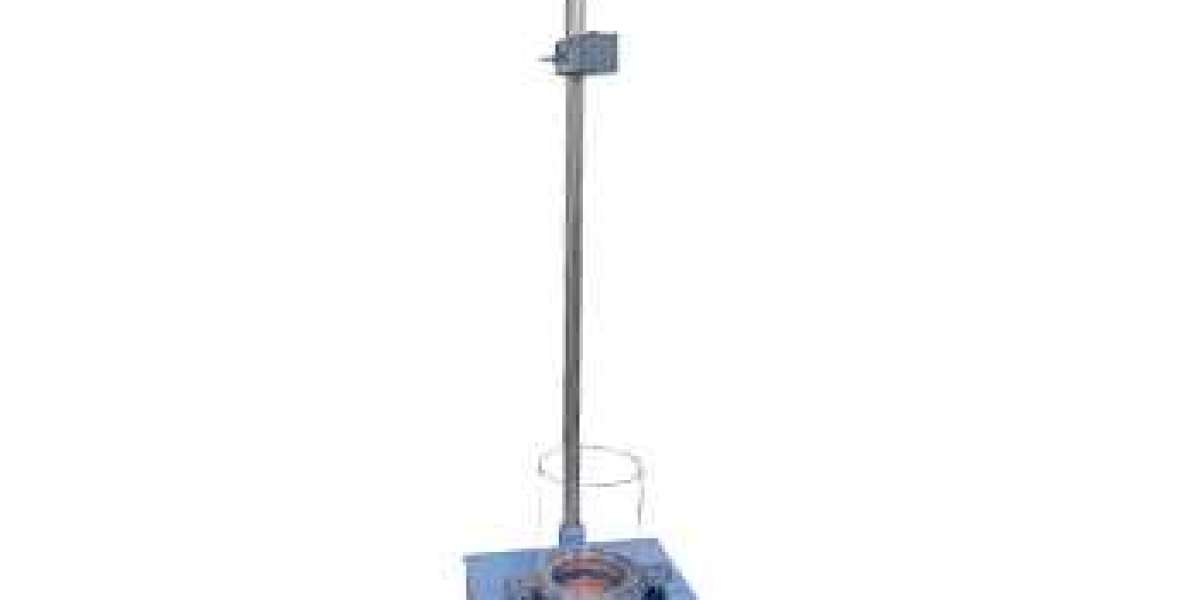Introduction
In today's competitive manufacturing landscape, ensuring the durability and reliability of products is paramount. The Drop Weight Impact Tester is a crucial piece of equipment that helps manufacturers achieve these goals by evaluating the impact resistance of materials. This article delves into the functionalities, applications, and benefits of the Drop Weight Impact Tester, highlighting its importance in quality control processes.
What is a Drop Weight Impact Tester?
A Drop Weight Impact Tester is a device used to measure the impact resistance of materials by dropping a specified weight from a predetermined height onto the test specimen. The impact energy absorbed by the material provides valuable insights into its toughness and resistance to sudden forces. This testing method is essential for materials that will be subjected to dynamic loads during their service life.
Key Components of a Drop Weight Impact Tester
- Frame and Base: The sturdy frame and base provide stability and ensure accurate test results.
- Drop Weight: The weight, which can be varied according to test requirements, is a crucial component that impacts the test specimen.
- Guiding System: Ensures the weight falls in a controlled and precise manner.
- Specimen Holder: Securely holds the test specimen in place during the impact.
- Data Acquisition System: Records and analyzes the impact data for accurate assessment of material properties.
Applications of the Drop Weight Impact Tester
The Drop Weight Impact Tester is widely used across various industries to assess the impact resistance of different materials:
- Plastic and Polymer Testing: Evaluating the toughness of plastic products such as pipes, films, and packaging materials.
- Metals and Alloys: Testing the impact resistance of metals and alloys used in construction, automotive, and aerospace industries.
- Composites: Assessing the durability of composite materials used in advanced engineering applications.
- Packaging: Ensuring packaging materials can withstand impacts during transportation and handling.
Benefits of Using a Drop Weight Impact Tester
- Enhanced Product Quality: By identifying materials with superior impact resistance, manufacturers can enhance the quality and reliability of their products.
- Cost Savings: Preventing material failure reduces costs associated with repairs, replacements, and recalls.
- Compliance with Standards: Helps in meeting international quality standards and regulations, ensuring market acceptance.
- Informed Material Selection: Provides valuable data that aids in selecting the most suitable materials for specific applications.
- Improved Safety: Ensures that materials used in critical applications, such as automotive and aerospace, are safe and reliable.
How to Operate a Drop Weight Impact Tester
Operating a Drop Weight Impact Tester involves several key steps to ensure accurate and reliable results:
- Specimen Preparation: Carefully prepare the test specimen according to specified dimensions and standards.
- Weight Selection: Choose the appropriate drop weight based on the material and test requirements.
- Setup: Secure the specimen in the holder and position the weight at the predetermined height.
- Testing: Release the weight and allow it to impact the specimen.
- Data Analysis: Collect and analyze the data to determine the material's impact resistance.
Maintenance and Calibration
Regular maintenance and calibration of the Drop Weight Impact Tester are essential to ensure its accuracy and longevity. This includes:
- Routine Inspections: Regularly inspect the device for any signs of wear or damage.
- Calibration: Periodically calibrate the machine to maintain its precision and accuracy.
- Cleaning: Keep the device clean and free from debris to ensure smooth operation.
Conclusion
The Drop Weight Impact Tester is an invaluable tool in the quality control arsenal of manufacturers. Its ability to accurately measure the impact resistance of materials ensures that products meet the highest standards of durability and reliability. By investing in this essential testing equipment, manufacturers can enhance product quality, reduce costs, and ensure compliance with industry standards.
For more information about the Drop Weight Impact Tester and other testing equipment, visit paccor.com.
FAQ: Drop Weight Impact Tester
- What is a Drop Weight Impact Tester?
Answer: A Drop Weight Impact Tester is a device used to measure the impact resistance of materials by dropping a specified weight from a predetermined height onto the test specimen. This test helps determine the material's toughness and its ability to withstand sudden forces.
- Why is impact testing important?
Answer: Impact testing is crucial for evaluating the durability and reliability of materials, especially those subjected to dynamic loads. It helps in ensuring that materials can withstand impacts during their service life, which is vital for safety and performance in various applications.
- What types of materials can be tested using a Drop Weight Impact Tester?
Answer: The Drop Weight Impact Tester can be used to test a wide range of materials, including plastics, polymers, metals, alloys, and composites. It is commonly used in industries such as construction, automotive, aerospace, and packaging.
- How does the Drop Weight Impact Tester work?
Answer: The tester works by dropping a specified weight from a predetermined height onto the test specimen. The impact energy absorbed by the material is then measured to determine its resistance to impact. The device typically includes a frame, drop weight, guiding system, specimen holder, and data acquisition system.
- What are the key benefits of using a Drop Weight Impact Tester?
Answer: Key benefits include enhanced product quality, cost savings, compliance with international standards, informed material selection, and improved safety. The tester helps manufacturers identify materials with superior impact resistance, reducing the risk of material failure and associated costs.
- How do I prepare a specimen for impact testing?
Answer: Specimen preparation involves cutting the material to specified dimensions and ensuring it meets the required standards for testing. Proper preparation is essential for obtaining accurate and reliable test results.
- What should I consider when selecting the drop weight for testing?
Answer: The selection of the drop weight depends on the material being tested and the specific test requirements. The weight should be chosen to provide a meaningful impact that can accurately assess the material's resistance.
- How is the impact data analyzed?
Answer: The impact data is recorded by the data acquisition system and analyzed to determine the material's impact resistance. This analysis provides insights into the material's toughness and its ability to absorb impact energy.
- How often should the Drop Weight Impact Tester be calibrated?
Answer: Regular calibration is essential to maintain the accuracy and precision of the tester. The frequency of calibration depends on the usage and manufacturer's recommendations, but it is generally advisable to calibrate the device periodically.
- What maintenance is required for the Drop Weight Impact Tester?
Answer: Routine maintenance includes regular inspections for wear or damage, cleaning the device to remove debris, and ensuring all components are in good working condition. Proper maintenance ensures the longevity and reliability of the tester.
- Can the Drop Weight Impact Tester be used for quality control in manufacturing?
Answer: Yes, the Drop Weight Impact Tester is an essential tool for quality control in manufacturing. It helps manufacturers ensure that materials meet the required impact resistance standards, leading to higher quality and more reliable products.
- Where can I learn more about the Drop Weight Impact Tester?
Answer: For more detailed information about the Drop Weight Impact Tester, its applications, and other testing equipment, visit paccor.com. The website offers comprehensive resources and support for all your testing needs.
If you have any additional questions or need further assistance, please feel free to contact our support team through the website.
About Drop Weight Impact Tester
Introduction
The Drop Weight Impact Tester is a critical instrument used across various industries to evaluate the impact resistance of materials. This sophisticated device plays a vital role in quality control and material selection processes, ensuring that products can withstand the rigors of real-world applications. Here, we provide an in-depth look at the Drop Weight Impact Tester, its components, functionalities, and significance.
What is a Drop Weight Impact Tester?
A Drop Weight Impact Tester is designed to measure the energy absorbed by a material when subjected to a sudden force. This is achieved by dropping a weight from a specified height onto the test specimen and recording the impact data. The resulting measurements provide valuable insights into the material's toughness and resilience, which are crucial for applications where dynamic loads are common.
Key Components
- Frame and Base: Provides a stable structure for accurate testing.
- Drop Weight: A customizable weight that varies according to the test requirements.
- Guiding System: Ensures the weight falls in a precise and controlled manner.
- Specimen Holder: Securely holds the test sample in place.
- Data Acquisition System: Collects and analyzes the impact data to determine the material's properties.
Applications
The Drop Weight Impact Tester is widely used in industries such as:
- Plastic and Polymer Testing: Assessing the impact resistance of products like pipes, films, and packaging.
- Metals and Alloys: Evaluating the toughness of materials used in construction, automotive, and aerospace.
- Composites: Testing the durability of advanced composite materials.
- Packaging: Ensuring that packaging materials can withstand impacts during transportation.
Benefits
- Enhanced Product Quality: Identifies materials with superior impact resistance, leading to more reliable products.
- Cost Savings: Reduces costs associated with material failure, repairs, and recalls.
- Compliance with Standards: Ensures materials meet international quality and safety standards.
- Informed Material Selection: Provides data to help select the best materials for specific applications.
- Improved Safety: Ensures that materials used in critical applications are safe and dependable.
How It Works
- Specimen Preparation: The test specimen is prepared according to specified standards.
- Weight Selection: The appropriate drop weight is chosen based on the test requirements.
- Setup: The specimen is secured in the holder, and the weight is positioned at the predetermined height.
- Testing: The weight is released to impact the specimen.
- Data Analysis: The impact data is collected and analyzed to determine the material's impact resistance.
Maintenance and Calibration
Regular maintenance and calibration are crucial for ensuring the accuracy and longevity of the Drop Weight Impact Tester. This includes:
- Routine Inspections: Checking for signs of wear or damage.
- Calibration: Periodically calibrating the device to maintain precision.
- Cleaning: Keeping the equipment clean to ensure smooth operation.
Conclusion
The Drop Weight Impact Tester is an indispensable tool in modern manufacturing and quality control. Its ability to accurately measure the impact resistance of materials ensures that products are durable, reliable, and meet the highest standards. Investing in this testing equipment enables manufacturers to produce superior products, reduce costs, and enhance overall safety.
For further information about the Drop Weight Impact Tester and other testing solutions, visit paccor.com. The website offers comprehensive resources and expert support to meet all your testing needs








